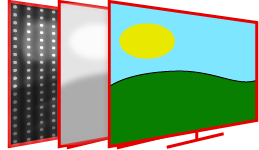Local Dimming on TVs
Direct-Lit, Full-Array, and Edge-Lit
Local dimming is a way for LED TVs to improve the contrast ratio in dark scenes by dimming backlight zones. This makes blacks appear deeper than they normally are without the feature, improving the overall picture quality. It's also an important feature for watching HDR content because it can help brighten highlights at the same time. However, usually only higher-end TVs have this feature, and not all of them are equally effective, as some can worsen the overall picture quality.
We test for local dimming using multiple testers that subjectively assign a score after watching a test video, paying attention to different aspects of the picture quality.
You can also read about local dimming in monitors here.
Test results
When It Matters
Local dimming is meant to increase contrast by making blacks look deeper in dark scenes. So, a TV with good local dimming is most noticeable when watching content in dark rooms. It's not as noticeable in bright rooms because blacks already appear dark when viewed in a well-lit environment due to glare on the screen.
Local dimming can be a clear benefit to picture quality, but it can also lead to blacks losing detail or blooming around bright objects. If local dimming sounds appealing, you should pay close attention to the results of this test to make sure you get a TV that implements this feature well.
Below you can see how local dimming improves the black level of the TCL 6 Series/R635 2020 QLED in our black uniformity test. However, at the same time, you can see that it also causes more blooming around the center cross, so for some TVs, there's a trade-off between improving the black level at the cost of blooming.
Our Tests
To test for local dimming, we use a video with a moving bright object to see how well the local dimming feature affects different aspects of the picture quality. Multiple testers subjectively assign a score to the overall local dimming performance by comparing it to other TVs. During the test, we make sure the local dimming feature is enabled and we adjust the backlight to have a brightness of 100 cd/m2.
We also take a video at a 45-degree angle to show how well the TV's local dimming performance. For TVs with narrow viewing angles, it may seem like there's more blooming, but for the most part, blooming is less visible when looking directly at the TV. During testing, we evaluate the TV's performance by viewing at a variety of angles and distances.
Local Dimming Video
As mentioned, our local dimming video represents how well the backlight can adjust when there's a moving bright image in a dark scene. We always show the maximum local dimming setting in the video, but we test for all the different local dimming settings and recommend which one performs best.
This test will show several things:
- Black Crush: When there's a bright object, sometimes the local dimming over-darkens the entire scene, resulting in highlights being 'crushed'. It's best if the TV avoids this.
- Blooming: Somewhat opposite of black brush, blooming causes bright objects to light up too many zones. This is noticeable when there's a glow around a bright object, like a street lamp or stars, and it could get distracting.
- Number and Size of Dimming Zones: With local dimming, different groupings of LEDs – called zones – are dimmed or brightened at the same time. With many small zones, it's easy to control how each zone affects the image. Fewer zones cover bigger areas of the screen, which could lead to more blooming. By looking at how much space is brightened around the white dot at any given time, you should be able to get an idea of the size of the zones. Also, we use this video to count the dimming zones. However, we don't publish how many zones there are because it's an estimate and not an exact number.
- Star Field: We use a Star Wars intro to evaluate how good the stars look. This is a way to see in real content whether there's blooming or black crush. On an ideal TV, each star is bright, and there's enough black space in between them.
- Subtitles: Sometimes, dimming zones are so big that they can't differentiate between subtitles and the content. If that's the case, subtitles can be over-brightened, or there's blooming around them, which could be distracting. You can see an example of bad subtitles here.
- Uniformity: Combined with our uniformity test, we see how uniform the screen is when there are bright highlights. We keep an eye out for any backlight bleed and blooming. Although our black uniformity test uses a test image, we use real content in this test and see if there are uniformity issues.
- Zone Transition Visibility and Speed: When a bright object moves between dimming zones, we want to see if there's any obvious blooming or if multiple zones light up. We also want to see how fast the zonal transitions are; does the new zone light up too fast, and how long does the old zone stay on the screen? If the local dimming feature is bad at these, it's distracting and can even create a 'Golf Ball Effect' as seen on the TCL 8 Series 2019/Q825 QLED.
Below are two examples of local dimming videos of different TVs from the same brand. The Vizio M Series 2018 has worse local dimming than the Vizio P Series Quantum X 2019. The M7 has fewer dimming zones, and fast-moving objects transition between zones slower.
In terms of scoring, we often compare the local dimming to that of other TVs before assigning a score. For example, we gave the TCL 5 Series/S535 2020 QLED a better score than the TCL 6 Series/R635 2020 QLED because we noticed how subtitles look better on the 5 Series than the 6 Series. A perfect score would go to a TV that can display very bright highlights next to deep blacks, without any blooming. While this is impossible for an LED TV to do, it's something all OLED TVs can do. Since it's subjectively assigned, it comes down to personal preference, and you simply may not like the local dimming on a TV that scores well, so feel free to play around with any local dimming settings on your TV.
Backlight
Another thing that we check for, but doesn't affect our scoring, is seeing what backlight type the LED TV uses. Direct/full-array backlighting means that there are LEDs placed all over behind a TV’s LCD panel. Edge-lit TVs only have LEDs along the sides of the screen (usually two opposing sides), and these LEDs are responsible for lighting the entire screen. They perform quite differently for local dimming, so this result is quite important.
In terms of testing, we list the TV as 'Full-Array' if it's direct-lit and has local dimming (Sony X900H), and as 'Direct LED' if it's direct-lit and doesn't have local dimming (Sony X800H). Being direct-lit enables the TV's local dimming feature to have more control over each zone, and makes it easier to turn off zones. On the other hand, edge-lit TVs like the LG NANO81 can’t dim LEDs located behind the relevant parts of the screen, so edge-lit local dimming tends to be much less precise. Local dimming features on edge-lit TVs are usually ineffective, don't improve the contrast all that much, and cause entire vertical or horizontal zones to light up when there's a bright object. Most TVs tend to have full-array local dimming features, but there are still some TVs with edge-lit panels. Also, many monitors use edge-lit local dimming features, and you can see how they cause multiple zones to light up here.
Local Dimming in Game Mode
As part of our Test Bench 1.6 update, we've introduced a 'Local Dimming in Game Mode' test. It's the same as the regular local dimming test, just in 'Game' mode. Some TVs require a different picture mode to get the lowest input lag possible for gaming. Most TVs' local dimming performs the same in 'Game' mode as in the regular picture mode, but, we've noticed some Samsung TVs have issues where their local dimming features aren't as effective in 'Game' mode, as you can see with the Samsung Q80/Q80T QLED.
Contrast Ratio with Local Dimming
With our contrast ratio testing, we also test the contrast ratio with the local dimming set to our recommended settings. This allows us to see how good the local dimming is at improving the contrast ratio, and most TVs do at least a good job of it. Local dimming on the Vizio P Series Quantum X 2020 greatly improves the contrast from 5078:1 to 14345:1, but on a few TVs, like the Vizio M7 Series Quantum 2020, the contrast decreases from 5356:1 to 4980:1. However, there could be a trade-off with some TVs that improve the contrast as they may also crush highlights too much, and this is why we have this test in the contrast ratio box and not local dimming.
Additional information
Why local dimming exists
LCD panels are backlit by LED lights, so they rely on a backlight behind the panel to make the picture visible, and the LCD layer can't prevent all light from escaping out of the screen. This means that even in a black scene, the backlight is still on, and some light escapes, causing blacks to appear gray.
In an attempt to mask this shortcoming, some LED TVs employ local dimming to target dark portions of the screen and dim the backlight in those areas. The intended result is that dark portions become darker, but everything else is left as bright as it should be, increasing the contrast between dark and light objects.
Downsides of local dimming
No local dimming feature is perfect on an LED TV, and it can introduce minor problems on some TVs, like:
- Light blooming around bright objects. You can see an example of that in the video above, on the left.
- A trail of light following moving bright objects. See the example above, on the right.
- A loss of detail in dark areas; often caused by black crush.
- Unintended portions of the screen being dimmed, but this is rare.
- Uniformity issues, like fluctuating brightness across the screen.
Local dimming on OLEDs
OLEDs use self-emitting pixels and don't have a backlight, and because of this, they don't have local dimming features. However, we score OLEDs as a perfect 10 for local dimming, because they do everything that a local dimming feature on an LED TV should do. Dark areas are completely off, leaving bright areas to stand out without any blooming.
How To Get The Best Results
Some TVs offer different local dimming settings. Low settings will usually dim the backlight less, but then the local dimming will also be less effective at improving the contrast. Higher settings will dim more, but may also make blooming, or other related issues, more visible. Local dimming preferences are subjective, so if you have multiple options, try out the different settings and choose the one you like best. Apart from that, there's no way to get better results from local dimming. If this is a feature that matters to you, be sure to get a TV that scores highly in this test.
Other Notes
- Contrast/Brightness: These settings aim to improve the contrast ratio by tinkering with the white and black levels. It doesn't have a direct effect on the local dimming but can improve the picture quality. The contrast setting increases the luminosity of the brightest whites, while brightness (sometimes called black level), makes blacks darker. Keep in mind the brightness setting on some TVs controls the backlight, which doesn't affect picture quality.
- Samsung's UHD Dimming: This processes the video in an attempt to mimic local dimming. It doesn’t dim the backlight but instead changes the contrast of different areas of the picture. Video purists usually dislike it, because it messes with the video settings of the TV, changing contrast from frame to frame. We don’t recommend using it.
- Frame dimming: Frame dimming, or CE dimming on Samsung TVs, is a basic version of local dimming, but it dims the entire backlight instead of zones. Usually found on edge-lit TVs, it causes small highlights to become dim as well. It may improve the contrast a bit, but it's not very useful for most scenes.
- HDR: A TV with a good local dimming implementation will do well with HDR because it can further brighten the highlights. Learn more about HDR.
Conclusion
Local dimming features on LED TVs are a way to improve the contrast ratio. Since these TVs consist of LED backlights behind an LCD panel, local dimming aims to turn off, or dim, certain zones of the LED backlight, making blacks look darker and highlights brighter. However, there may be some issues with local dimming on some TVs as it could cause blooming around bright objects or for entire zones to light up when there's a small object. Overall, most local dimming features on modern TV do an effective job at improving the picture quality in dark scenes, and only some lower-end models will have glaring problems.



